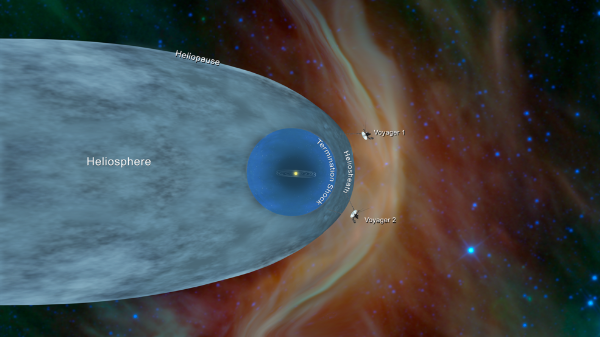Escaping the Heliosphere
Humanity has another interstellar emissary.
After launching in 1977, NASA’s trailblazing spacecraft Voyager 2 has finally escaped the heliosphere, the Sun’s protective bubble of charged particles. It follows in the path of its sibling, Voyager 1, which crossed into interstellar space in 2012.
At a news conference Monday at the 2018 fall meeting of the American Geophysical Union (AGU) in Washington, D.C., Ed Stone, project scientist for the unmanned Voyager missions since 1972, explained the three pieces of evidence that led the team to this conclusion.
How You Know You’re Interstellar
First, there are intense galactic cosmic rays that permeate interstellar space. Some of these rays get into the heliosphere, but the team expected that spacecraft would detect a slow increase in cosmic rays as it neared the heliopause, and then a sudden increase when it crossed the boundary. And, on November 5, the craft detected just such a sudden and extreme increase in cosmic rays.
Second, the team expected the craft to detect dramatically fewer of the charged particles that make up the heliosphere once the it crossed the heliopause. And, also on November 5, Voyager 2 suddenly registered fewer of these particles.
Third, the team expected the craft to detect a sudden jump in magnetic field intensity as it crossed over out of the heliosphere, which it also saw.
Onward
While these findings show that the spacecraft has crossed this line from the heliosphere into interstellar space, it does not mean Voyager 2 has left the solar system. While the heliosphere does encompass the Sun and all of the planets in our solar system, there are still comets and other icy bodies in the Oort Cloud, which lies outside the heliosphere, that are part of our solar system. So while the craft has gone interstellar, it can’t be said that it has completely left the solar system. (Neither has Voyager 1, which left the heliosphere several years ago.)
Voyager 2 will continue to study the cosmos from the other side of the heliopause, as Voyager 1 has been since 2012. Suzanne Dodd, NASA Jet Propulsion Laboratory’s Director for the Interplanetary Network Directorate, estimated at the conference that the craft will continue to transmit data back to us for perhaps another decade.
“This is an extremely exciting time for the history of space exploration where we’re able to actually look at the galaxy through the clouded lens of our heliosphere and now take a step outside with Voyager and for the first time contemplate the vistas of our local galactic neighborhood,” NASA researcher and astrophysicist Georgia de Nolfo said at the conference.










